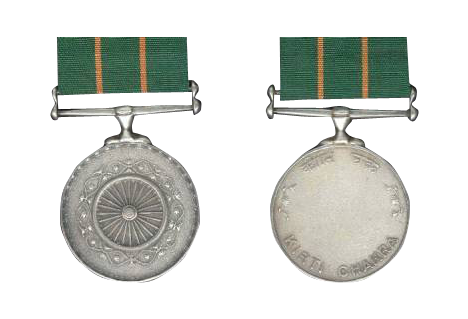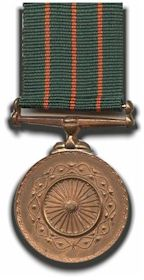Important Facts For Prelims
Gallantry Awards
- 11 May 2023
- 5 min read
Why in News?
Recently, President of India presented gallantry awards to 37 personnel of the armed forces, paramilitary, and police forces for their bravery and valour in the line of duty. Eight personnel were conferred with the Kirti Chakra, and 29 personnel received the Shaurya Chakra.
What are the Gallantry Awards in India?
- Post-Independence, the first three gallantry awards namely Param Vir Chakra, Maha Vir Chakra, and Vir Chakra were instituted by the government of India on 26th January 1950 and were deemed to have effect from 15th August 1947.
- Thereafter, three other gallantry awards — the Ashoka Chakra Class-I, the Ashoka Chakra Class-II, and the Ashoka Chakra Class-III — were instituted in 1952 and were deemed to have effect from 15th August 1947.
- These awards were renamed Ashoka Chakra, Kirti Chakra, and Shaurya Chakra respectively in January 1967.
- Order of precedence of these awards is the Param Vir Chakra, the Ashoka Chakra, the Mahavir Chakra, the Kirti Chakra, the Vir Chakra, and the Shaurya Chakra.
- The gallantry awards are announced twice in a year — first on the occasion of the Republic Day and then on the occasion of the Independence Day.
What is Kirti Chakra?
- About:
- It is the peacetime equivalent of the Maha Vir Chakra, the second-highest peacetime gallantry award.
- Awarded for displaying conspicuous gallantry, indomitable courage, and extreme devotion to duty. or self-sacrifice away from the field of battle.
- Eligibility and Design:
- Open to civilians as well as military personnel, including posthumous awards.
- A circular silver medal with a lotus flower in the center and a chakra around it, suspended from a green ribbon with two orange stripes.
What is Shaurya Chakra?
- About:
- An Indian military decoration awarded for gallantry, courageous action, or self-sacrifice while not engaged in direct action with the enemy.
- Represents the spirit of bravery, valor, and devotion to duty in peacetime.
- Eligibility and Design:
- Open to civilians as well as military personnel, including posthumous awards.
- Circular bronze medal with a replica of the Ashoka Chakra, the national emblem of India, in the center.
- Features a lotus wreath around the Ashoka Chakra symbol.
- Suspended from a green ribbon with three vertical lines.
UPSC Civil Services Examination, Previous Year Questions (PYQs)
Q. Consider the following statements in respect of Bharat Ratna and Padma Awards: (2021)
- Bharat Ratna and Padma Awards are titles under the Article 18(1) of the Constitution of India.
- Padma Awards, which were instituted in the year 1954, were suspended only once.
- The number of Bharat Ratna Awards is restricted to a maximum of five in a particular year.
Which of the above statements are not correct?
(a) 1 and 2 only
(b) 2 and 3 only
(c) 1 and 3 only
(d) 1, 2 and 3
Ans: (d)
Exp:
- The Padma Awards are announced annually on Republic Day. It was instituted in 1954 and is one of the highest civilian honours of India. The awards are given in three categories:
- Padma Vibhushan (for exceptional and distinguished service)
- Padma Bhushan (distinguished service of higher order)
- Padma Shri (distinguished service)
- Article 18(1) prohibits the State to confer titles on anybody whether a citizen or a non-citizen. Military and academic distinctions are, however, exempted from the prohibition. Bharat Ratna and Padma Awards are not titles under the Article 18(1). Hence, statement 1 is not correct.
- Padma Vibhushan is highest in the hierarchy of Padma Awards followed by Padma Bhushan and Padma Shri.
- The Padma Awards were suspended during the years 1978, 1979 and 1993 to 1997. Hence, statement 2 is not correct.
- Bharat Ratna is the highest civilian award of the country. It is awarded in recognition of exceptional service/performance of the highest order in any field of human endeavour.
- The recommendations for Bharat Ratna are made by the Prime Minister to the President of India. The number of Bharat Ratna Awards is restricted to a maximum of three in a particular year. Hence, statement 3 is not correct.
- Therefore, option (d) is the correct answer.







